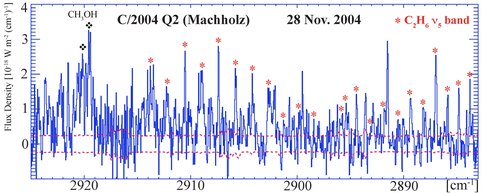2009 Annual Science Report
 NASA Goddard Space Flight Center
Reporting | JUL 2008 – AUG 2009
NASA Goddard Space Flight Center
Reporting | JUL 2008 – AUG 2009
Accomplishments of Graduate Student Yana L. Radeva
Project Summary
During the time period July 1, 2008 – June 30, 2009, Yana L. Radeva who is a fifth year Ph.D. Student in the Department of Astronomy at the University of Maryland refined and finalized her analysis of the organic composition of comet C/2000 WM1 (LINEAR). The comet was observed with the Near Infrared Echelle Spectrograph on the Keck II telescope on 23, 24 and 25 Nov. 2001.
Project Progress
Yana L. Radeva is a fifth year Ph.D. student in the Department of Astronomy at the University of Maryland, College Park. She is now entering the final year of her dissertation research, with advisors Dr. Michael Mumma (NASA GSFC) and Dr. Michael A’Hearn (University of Maryland).
During the time period July 1, 2008 – June 30, 2009, she refined and finalized her analysis of the organic composition of comet C/2000 WM1 (LINEAR). The comet was observed with the Near Infrared Echelle Spectrograph on the Keck II telescope on 23, 24 and 25 Nov. 2001. Radeva obtained production rates, rotational temperatures and abundances relative to water for the detected parent volatiles: CH4, C2H2, C2H6, H2CO, CH3OH, HCN, CO, along with H2O. The results indicate that WM1 is depleted in organic parent volatiles, and there is no secure evidence for heterogeneity of this comet’s nucleus (based on mixing ratios derived for the three consecutive dates of observation). A paper describing the results is in press (Icarus, the International Journal of Solar System Studies). Radeva also presented her results at the Asteroids, Comets, Meteors Conference (Baltimore, MD, July 2008), and at the Division for Planetary Sciences Conference (Cornell University, October 2008). Radeva also participated in observations of comet C/2007 N3 Lulin with NIRSPEC on the Keck II telescope (Mauna Kea, Hawaii) in March 2009.
In another major part of her dissertation research, Radeva completed the development of a fluorescence model for the ν5 band of C2H6 near 3.4 µm (see Figure 1 for region of interest). While the ethane ν7 band (3.35 µm) provides an accurate production rate (only), the ν5 band permits measurement of both an absolute production rate AND an accurate rotational temperature. Thus, the rotational temperature for C2H6 (from ν5) can be compared with the temperatures obtained simultaneously for HCN and H2O (in the KL2 setting of NIRSPEC), to further assist in quantifying aspects of molecular release and outflow from the cometary nucleus. Her work also permits the extraction of quantitative production rates for eight parent volatiles simultaneously using a single instrument setting (H2O, NH3, HCN, C2H2, CH2, C2H6, H2CO, and HDO). She has applied this new fluorescence model to comets WM1, 17P/Holmes, and C/2004 Q2 (Machholz), and is now applying it to additional comets, in order to better constrain the derived rotational temperatures, production rates, and mixing ratios for C2H6.
The flux density scale is shown at left, and the ±1s noise envelope is shown as dashed lines around zero. Spectral lines of C2H6 ν5 and CH3OH are seen.
-
PROJECT INVESTIGATORS:
-
PROJECT MEMBERS:
Yana Radeva
Doctoral Student
-
RELATED OBJECTIVES:
